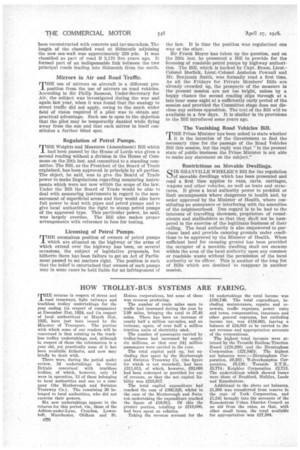HOW TROLLEY-BUS SYSTEMS ARE FARING.
Page 10

If you've noticed an error in this article please click here to report it so we can fix it.
THE returns in respect of street and road tramways, light railways and trackless trolley undertakings for the year ending (in respect of companies) at December 31st, 1924, and (in respect of local authorities) at March 31st, 1925, have just been issued by the Minister of Transport. The portion with which some of our readers will be concerned is that relating to the trackless trolley undertakings, and, although in respect of those the information is 41; year old, yet practically none of it has been available hitherto, and now may briefly be dealt with.
There were, during the period under review, 34 undertakings in Great Britain concerned with trackless trollies, of which, however, only 14 were in operation, 13 of these belonging to local authorities and one to a company (the Mexborough and Swinton Tramway Co.). The remaining 20 belonged to local authorities, who did not exercise their powers.
Six new undertakings appear in the returns for this period, viz., those of the Ashton-under-Lyne, Croydon, Lowestoft, Manchester, Oldham and St. Helens corporations, but none of these was revenue producing.
The number of route miles open to traffic had increased during the year by 2.99 miles, bringing the total to 57.48 miles. There has been an increase of nearly half a million car-miles, and an increase, again, of over half a million traction units of electricity used.
The number of passengers carried by trolley-buses had increased by nearly six millions, so that over 24Amillion passengers were carried in the ear.
The total capital paid up, but excluding that spent by the Mexborough and Swinton Tramway Co. (the figure for which is not recorded), had been 1311,015, of which, however, £92,098 had been redeemed or provided for out of revenue, so that the net capital liability was 1218,917.
The total capital expenditure had reached the sum of £365,829, whilst in the case of the Mexborough and Swinton undertaking the expenditure reached the figure of £16,911. Of this the greater portion, totalling to £210,000, had been spent on vehicles.
Taking the revenue account for the
14 undertakings the total income was £158,746. The total expenditure, including maintenance, repairs and renewals, traffic expenses, power rates and taxes, compensation, insurance and other general expenses, but excluding income tax, was 1134,663, leaving a balance of £24,083 to be carried to the net revenue and appropriation accounts of the corporations.
The highest total incomes were attained by the Teesside Railless Traction Board (£28,296) and the Birmingham Corporation (127,845). The highest net balances were :—Birmingham Corporation. £9,282 ; Wolverhampton Corporation, 16,126; Teesside R.T.B., 15,774; Keighley Corporation £2,713. The undertakings -which showed losses were those of Bradford, Halifax, Leeds and Ramsbottom.
Additional to the above net balances, £1,200 was transferred from reserve in the ease of York Corporation, and £1,541 brought into the accounts of the Ramshottom -Urban District Council as an aid from the rates, 80 that, with other small items, the total available for appropriation was £27,504.
































